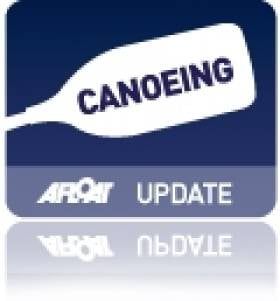Displaying items by tag: Final,
# ROWING: Sanita Puspure moved into the A Final of the World Cup in Munich today with a steady performance which saw her finish third in the semi-final behind Nataliya Mustafayeva of Azerbaijan and Emma Twigg of New Zealand. Puspure established her hold on third by the middle stages of the race and let the top two fight it out while she saw off a challenge by Talia Gjoertz of New Zealand with an effective push.
Puspure also made the A Final in the other World Cup in which she competed, in Belgrade last month. She finished fifth.
Claire Lambe finished 15th overall in the lightweight single scull. She finished third in the C Final: leading into the closing stages, she was passed by both Anna Ioannou of Cyprus and, coming up to the line, Lila Perez Rul of Mexico.
Ireland's Adpative mixed coxed four won their B Final to finish seventh overall.
World Cup Regatta, Munich (Irish interest)
Women
Single Scull – Semi-Finals (First Three to A Final; rest to B Final) – Semi-Final One: 1 Belarus (E Karsten) 7:59.28, 2 Denmark (FU Erichsen) 8:01.68, 3 Lithuania (D Vistartaite) 8:03.58. Semi-Final Two: 1 Azerbaijan (N Mustafayeva) 8:08.36, 2 New Zealand (E Twigg) 8:12.60, 3 Ireland (S Puspure) 8:15.32; 4 Norway 8:17.43, 5 Italy 8:24.12, 6 8:26.14.
Lightweight Single – C Final (places 13 to 18): 1 Cyprus (A Ioannou) 8:05.74, 2 Mexico (L Perez Rul) 8:10.38, 3 Ireland (C Lambe) 8:14.94, 4 Hong Kong 8:17.74, 5 Croatia 8:23.63. Finland did not start.
Adpative - Legs, Trunk and Arms Mixed Coxed Four (1,000m) – B Final (Places 7, 8): 1 Ireland (AM McDaid, S Caffrey, S Ryan, K du Toit; cox: H Arbuthnot) 3:44.18, 2 Belarus 3:51.75
#CANOEING: Ciaran Heurteau first represented Ireland in 2006, but he reached new heights today when he finished fifth in the canoe slalom World Cup final in Pau in the Pyrenees.
The 24-year-old, who was brought up in Paris but has an Irish mother, qualified for the final by finishing third in the semi-final, and he competed well. Chasing an exceptional mark of 100.17 seconds set by Etienne Daille of France, Heurteau came down the course in 102.32 seconds, but he had touches on gates 12 and 24 (the second last on the course), which resulted in four seconds in time faults. Daille took gold, while Heurteau was less than a second off a bronze medal.
Canoe Slalom World Cup, Pau, France (Irish interest)
Men,
K1 Semi-Final (First 10 to Final) : 3 C Heurteau 101.74; 22 E Rheinisch 106.90
Final: 1 France (E Daille) 100.17, 2 Czech Republic (J Vondra) 101.46, 3 Australia (L Delfour) 105.40; 5 Ireland (C Heurteau) 106.32.
#ROWING: Ireland's Sanita Puspure fought her way into the A Final of the single scull at the World Cup in Belgrade this afternoon. With Xiuyun Zhang and world champion Mirka Knapkova colonising the first two places, it became a race between Puspure and Kaisa Pajusalu for the crucial third qualifying spot. A push in the third quarter was decisive for Puspure, who held off a late challenge from Pajusalu and had almost five seconds to spare on the line. Pajusalu, a former world champion at under-23 level, was 12th in the world last year in this class.
World Cup, Belgrade – Day Two (Irish interest)
Men
Lightweight Double Scull – C Final (places 13 to 18): 1 Austria Two 6:24.17, 2 Austria Three 6:24.21, 3 Slovenia Two 6:26.16, 4 Croatia 6:26.66, 5 Ireland (M O’Donovan, N Kenny) 6:26.67, 6 Austria One 6:27.57.
Lightweight Single – C Final: Ireland (M Maher) did not start.
Women
Single Scull – A/B Semi-Final (First Three to A Final; rest to B Final): 1 China (X Zhang) 7:18.59, 2 Czech Republic (M Knapkova) 7:18.81, 3 Ireland (S Puspure) 7:27.27; 4 Estonia (K Pajusalu) 7:32.15, 5 Serbia Two (I Filipovic) 7:43.16, 6 Ukraine (N Huba) 7:48.97.
Lightweight Single Scull – Repechage (First Four to A/B Semi-Final): 1 Switzerland (P Weisshaupt) 7:55.81, 2 Ireland (C Lambe) 7:57.35, 3 Sweden One (C Lilja) 7:58.63, 4 Croatia (H Pavkovic) 8:01.57; 5 Sweden Two (L Kalstroem) 8:06.42.































































